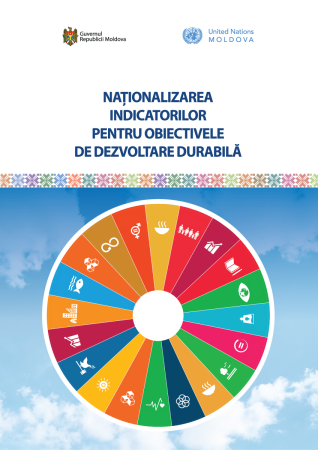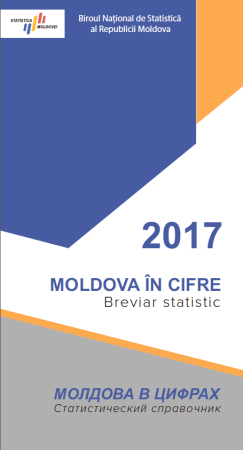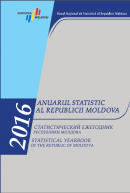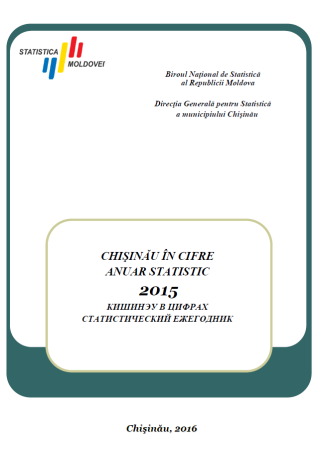"Energy balance of the Republic of Moldova", edition 2017 posted
This compilation contains detailed information on the creation of primary and total energy resources, distribution and final consumption of energy by main economic activities and branches of industry, as well as the characteristic of energy equipment: installed capacity of electric power stations, consumption of fuel for production of electricity and thermal energy.
755
"Quarterly statistical bulletin, January-June 2017" posted on the website
The bulletin contains data in dynamics in the form of tables on main statistical indicators for years, quarters, months, which characterize the social, economic and demographic situation of the country. Information on social and economic situation of CIS countries is presented. For the main indicators there are presented methodological notes.
768
The quarterly publication "Social-economic situation of the municipality Chisinau in January-June 2017" posted on the website
The publication contains quarterly statistical information which presents the economic, social and demographic situation of the municipality Chisinau. The publication contains statistical indicators regarding demographic situation, work remuneration, health, tourism, crimes, agriculture, industry, investments in long-term assets, construction, transport.
787
The statistical publication "Aspects of the standard of living of population in 2016" was posted on the website
The publication contains information regarding main social and economic aspects which characterize the welfare level of the population, especially incomes, expenditures, housing conditions, availability of durable goods, household food consumption etc.
1321
The statistical compilation "Labour force in the Republic of Moldova. Employment and unemployment", edition 2017 posted on the website
The statistical compilation contains information regarding the labour market in the Republic of Moldova in 2016, compared to previous years. There are presented data regarding economically active population, employment and unemployment by activities, age groups, sex, area, level of education etc.
1328
Vacancy: UNFPA and UN contracts National Consultant
UNFPA and UNDP aim to contract a national consultant to support development in a participatory manner of the Operational Plan of the Strategy of Development of National Statistical System 2016 – 2020 based on Results-Based Management.
739
UN - World Bank Mission preceding the development of the National Strategy for Sustainable Development "Moldova 2030"
Deputy General Director of the National Bureau of Statistics, Iurie Mocanu, had a meeting with the UN-World Bank joint delegation, being on a working mission in Chisinau during 17-21 July 2017. The participants discussed the gaps identified in the process of nationalization of sustainable development indicators, including the lack of many global indicators in national data sources, limited access to data produced by certain public authorities, the insufficiency of data disaggregation.
1715
The statistical pocket-book "Moldova in figures, edition 2017", posted on the website
National Bureau of Statistics informs that the publication "Moldova in figures, edition 2017" was published in electronic format on the website.The pocket-book contains statistical information and analysis regarding demographic, social and economic situation of the country for 2013-2016.
1241
The statistical publication "Education in the Republic of Moldova" edition 2017 has been posted on the website in electronic format
The publication contains main statistical indicators that characterize the educational system of the country furring the period 2010-2016. Data are represented by educational levels: general section, pre-primary education, primary and general secondary education, secondary vocational education, postsecondary vocational education, higher education, doctorate and postdoctorate, regional statistics, international statistics.
1297
Statistical publication "Agricultural activity of small agricultural producers in the Republic of Moldova in 2016" posted on the website
National Bureau of Statistics informs, that the statistical publication "Agricultural activity of small agricultural producers in the Republic of Moldova in 2016", edition 2017 was published in electronic format on the website.
737
The quarterly publication "Social-economic situation of the municipality Chisinau in January-March 2017" posted on the website
The publication contains quarterly statistical information which presents the economic, social and demographic situation of the municipality Chisinau. The publication contains statistical indicators regarding industry, agriculture, investments in long term tangible assets and construction, transport, communications, tourism, domestic trade of goods, insurance, work remuneration, labour force market, unemployment, demographic situation, crimes.
737
"Quarterly statistical bulletin, January-March 2017" posted on the website
The bulletin contains data in dynamics in the form of tables on main statistical indicators for years, quarters, months, which characterize the social, economic and demographic situation of the country.
772
"Socio-economic situation of the Republic of Moldova in Janaury-March 2017" was posted
The publication contains flash information with the economic analysis of the main indicators, and also tables and diagrams with statistical data on the socio-economic and demographic situation of the country.
1113
Statistical Yearbook of the Republic of Moldova, edition 2016, was posted on the website
The Yearbook is structured in 24 chapters and includes 330 tables and diagrams. Each chapter contains methodological notes for basic indicators. In the final part of the Yearbook data on international statistics are presented, fact that gives possibility to compare the indicators for the Republic of Moldova with those of other countries.
1291
The Population of the Republic of Moldova at the time of the Census was 2 998 235
National Bureau of Statistics announced today the results of the 2014 Population and Housing Census, which was conducted from 12 to 25 May of the same year. The estimates showed that as many as 2 998 235 people were covered in total by the census, of which 2 789 205 with habitual residence. As many as 193 434 people were not included in the PHC.
9221
The quarterly publication "Social-economic situation of the municipality Chisinau in January-December 2016" posted on the website
The publication contains quarterly statistical information which presents the economic, social and demographic situation of the municipality Chisinau. The publication contains statistical indicators regarding industry, agriculture, investments in long term tangible assets and construction, transport, communications, tourism, domestic trade of goods, insurance, work remuneration, labour force market, unemployment, demographic situation, crimes.
1046
"Quarterly statistical bulletin, January-December 2016" posted on the website
The bulletin contains data in dynamics in the form of tables on main statistical indicators for years, quarters, months, which characterize the social, economic and demographic situation of the country. Information on social and economic situation of CIS countries is presented. For the main indicators there are presented methodological notes.
847
The statistical quarterly bulletin "Main social and economic indicators of the regions, counties and municipalities in January-December 2016" posted on the webpage
The quarterly operative information is given on industry, agriculture, investments in long term tangible assets and construction, transport, work remuneration, demography, crimes. The bulletin contains data on main statistical indicators of regions, counties, municipality Chisinau and municipality Balti.
1237
The statistical report "Socio-economic situation of the Republic of Moldova in 2016" posted on the website
The publication contains flash information with the economic analysis of the main indicators, and also tables and diagrams with statistical data on the socio-economic and demographic situation of the country in 2016.
1265
Statistical yearbook "Chisinau in figures" edition 2016 posted on the webpage
The Statistical yearbook "Chisinau in figures" is the most complete publication, which comprises statistical data regarding the demographic, social and economic situation of the municipality. The yearbook is structured in 16 chapters, containing information from various fields.
1168
reset WAYcursor WAYcontrast WAYMarire Font WAYCiteste cu voce textul selectat WAYLinkuri WAY





















